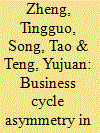| Srl | Item |
| 1 |
ID:
097832


|
|
|
|
|
| Publication |
2010.
|
| Summary/Abstract |
Friedman's plucking model of business fluctuations suggests that output cannot exceed an upper limit, but it is occasionally "plucked" downward below trends as a result of economic recessions. This paper investigates China's business fluctuations using quarterly real GDP data for the period 1978-2009. Our results show some evidence supporting Friedman's plucking model. We find that a ceiling effect of real output exists, and that negative asymmetric shocks significantly affect the transitory component, which captures the plucking downward behavior during the recession. The results also suggest that the basic asymmetric unobserved component model is not appropriate for directly modeling China's real output because the business cycle is inaccurately measured, but it works quite well when considering a structural break in the second quarter of 1992. The results reveal that although China's economy strengthened in the second quarter of 2009, it is essential for China's government to take further positive and effective measures to maintain sustainable development of the economy.
|
|
|
|
|
|
|
|
|
|
|
|
|
|
|
|
| 2 |
ID:
110249


|
|
|
|
|
| Publication |
2012.
|
| Summary/Abstract |
This paper introduces a regime-switching forward-looking Taylor rule to describe the monetary policy behavior and considers its estimation using a two-step MLE procedure due to Kim and Nelson (2006), Kim (2009) and Zheng and Wang (2010). By doing an empirical analysis on quarterly data for China over the period 1992-2010, our results show that the actual reactions of China's monetary policy can be well characterized by a two-regime forward-looking Taylor rule. Furthermore, it is also suggested that the interest rate policy in response to inflation and output gap is asymmetric, behaving a significant characteristic of regime-switching nonlinearity. Specifically, in the first regime the People's Bank of China targets inflation, but not focuses on the output gap; while in the second regime the central bank targets the output gap and the policy rule is not a stable framework.
|
|
|
|
|
|
|
|
|
|
|
|
|
|
|
|